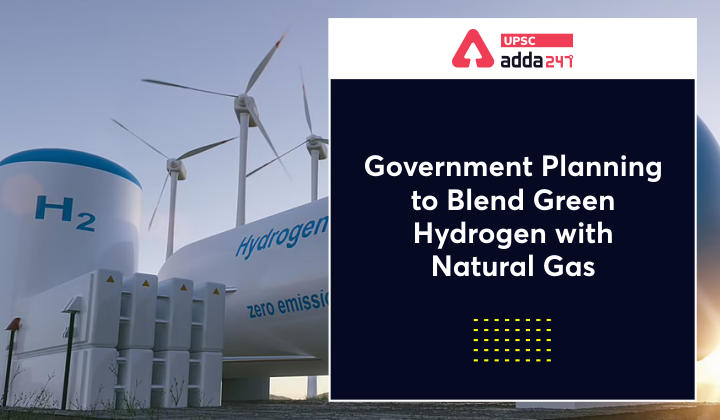Table of Contents
Green Hydrogen: Relevance
- GS 3: Infrastructure: Energy, Ports, Roads, Airports, Railways etc.
Green Hydrogen: Context
- Recently, the Government has said that it is planning to blend 15% green hydrogen with piped natural gas for domestic, commercial and industrial consumption.
About hydrogen blending with PNG
- The initiative will be in line with India’s ambitious targets for reducing greenhouse gas emissions and becoming carbon neutral by 2070.
- It will be a part of the government’s National Hydrogen Energy Mission, which is aimed at generating hydrogen from green power sources.
- Government is planning to float bids for manufacturing green hydrogen, which will be supplied to fertiliser units and petroleum refineries.
- Similarly, the plan is also to supply green hydrogen for PNG. The government will offer free transmission (of power) for this like in the case of RE.
- The objective is to blend 15 per cent green hydrogen with PNG, as it is technically viable.
Green hydrogen: Earlier initiatives
- Government had announced that it will bring green hydrogen under renewable purchase obligation (RPO).
- Renewable Purchase Obligation: It means that bulk buyers such as Discoms and captive users have to buy a certain proportion of renewable energy (RE) out of their total power requirement.
- Government has said that similar mechanism will be created for hydrogen and it will be called hydrogen purchase obligation (HPO).
Hydrogen Purchase Obligation (HPO).
- The HPO will cover industries like oil refineries and fertiliser plants, which use grey hydrogen.
- The idea is to create demand for green hydrogen. HPO is likely to come from 2023.
Benefits of Hydro energy
- Hydrogen is a flexible energy carrier and can be used for many energy applications like integration of renewables and transportation.
- Clean energy: Hydrogen is produced using RE and electrolysis to split water and is distinct from grey hydrogen, which is produced from methane and releases greenhouse gases.
- Energy can be extracted from hydrogen through combustion or through fuel cells, which emit only water as a by-product.
International efforts with hydrogen
- Europe and North America are planning to mix green hydrogen with PNG.
- In the UK, power utilities are blending hydrogen into pipelines to fuel power plants, industrial applications and to serve homes. The mixing is around 15-20% in some networks.
- Moreover, there are various pilot projects on hydrogen blending with PNG being tested in countries like the Netherlands, Germany, France, Australia, South Korea and Japan.
Disadvantages of hydrogen blending
- A study conducted by the US Energy Department’s National Renewable Energy Laboratory (NREL) in 2013stated that, it is not known how hydrogen will affect the pipelines it travels in and appliances that use it.
- On the pipeline front, hydrogen embrittlement can weaken metal or polyethylene pipes and increase leakage risks, particularly in high-pressure pipes.
- Hydrogen embrittlement occurs when the metal (pipeline) becomes brittle due to diffusion of hydrogen into the material.
Read about hydrogen related articles
Green Hydrogen Production in India: Scaling-up Alkaline Electrolyser technology





 TSPSC Group 1 Question Paper 2024, Downl...
TSPSC Group 1 Question Paper 2024, Downl...
 TSPSC Group 1 Answer key 2024 Out, Downl...
TSPSC Group 1 Answer key 2024 Out, Downl...
 UPSC Prelims 2024 Question Paper, Downlo...
UPSC Prelims 2024 Question Paper, Downlo...
